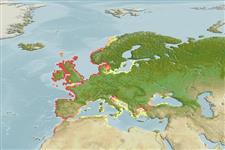Bivalvia |
Adapedonta |
Pharidae
Environment: milieu / climate zone / गहराई सीमा / distribution range
पारिस्थितिकी
; खारा; गहराई सीमा 3 - 14 m (संदर्भ 113231), usually 3 - 7 m (संदर्भ 105455). Subtropical; 69°N - 30°N, 11°W - 36°E
Northeast Atlantic and the Mediterranean: from Norwegian Sea and the Baltic, south to the Iberian Peninsula, into the Mediterranean, and along the Atlantic coast of Morocco.
Length at first maturity / आकार / Weight / Age
परिपक्व अवधि: Lm ? range ? - ? cm Max length : 15.5 cm SHL पुल्लिंग / अलिंग; (संदर्भ 2758)
Minimum depth from Ref. 105455. It is a sessile-burrower, suspension feeder (Ref. 96498). Occurs in fine sand (Ref. 105213). In general, suspension feeding bivalves mainly depend on phytoplankton and detritus material for nutrition (Ref. 107088).
Life cycle and mating behavior
परिपक्व अवधि | पुनरुत्पत्ति | मछलीऔ का अंडे देना | Eggs | Fecundity | Larvae
Members of the class Bivalvia are mostly gonochoric, some are protandric hermaphrodites. Life cycle: Embryos develop into free-swimming trocophore larvae, succeeded by the bivalve veliger, resembling a miniature clam.
Tuck, I.D., N. Bailey, M. Harding, G. Sangster, T. Howell, N. Graham and M. Breen 2000 The impact of water jet dredging for razor clams, Ensis spp., in a shallow sandy subtidal environment. Journal of Sea Research 43:65-81. (संदर्भ 2699)
IUCN Red List Status
(संदर्भ 130435: Version 2025-1)
CITES status (संदर्भ 108899)
Not Evaluated
CMS (संदर्भ 116361)
Not Evaluated
Threat to humans
Human uses
मात्स्यिकी: व्यापारिक
| FishSource | Sea Around Us
साधन
अधिक जानकारी
Life cycleपुनरुत्पत्तिपरिपक्व अवधिFecundityमछलीऔ का अंडे देनाEggsEgg developmentLarvae PhysiologyOxygen consumption
Human RelatedStamps, coins, misc.
इंटरनेट स्रोत
Estimates based on models
Preferred temperature
(Ref.
115969): 9 - 18.8, mean 11.4 (based on 555 cells).
लौटाव
ऊंचा, न्यूनतम जनसंख्या दुगनी समय अवलागत 15 महीने। (K=0.7).
Fishing Vulnerability
Low vulnerability (16 of 100).
Price category
Unknown.
Nutrients : Calcium = 149 [71, 228] mg/100g; Iron = 8.53 [1.95, 15.11] mg/100g; Protein = 9.88 [8.64, 11.12] %; Omega3 = 0.313 [0.202, 0.423] g/100g; Selenium = 61 [50, 72] μg/100g; VitaminA = 0 μg/100g; Zinc = 2.04 [0.56, 3.51] mg/100g (wet weight); based on
nutrient studies.
